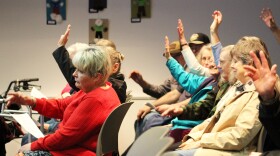The federal government is pumping several more million dollars into mariculture development on the Kenai Peninsula. Mariculture refers to marine farming, or aquaculture in marine environments. In Alaska, that usually looks like shellfish and kelp farming.
The U.S. Economic Development Administration announced on Thursday that it was awarding a $3.1 million grant to the Chugach Regional Resources Commission to help boost mariculture workforce development on the Kenai Peninsula.
According to a press release from the U.S. Department of Commerce, the money will be used to expand the Alutiiq Pride Marine Institute. That’s a tribally managed marine research facility in Seward established after the Exxon Valdez Oil Spill to support coastal indigenous communities in Alaska.
Award of the grant comes amid heightened interest in mariculture on the Kenai Peninsula and in Alaska. The Department of Commerce awarded $49 million to the Alaska Mariculture Cluster in 2022. That cohort brought together organizations from around the state interested in advancing mariculture operations in their region.
It includes the Kenai Peninsula Economic Development District, or KPEDD, which has helped spearhead local efforts to better develop mariculture as an industry on the peninsula. The organization gave mariculture its own panel during its annual Industry Overview Forum held earlier this year.
Cassidy Cameron is KPEDD’s executive director and spoke at the forum in April. Shortly after taking over as head of that organization, Cameron pointed to mariculture as one of the peninsula’s key emerging industries.
“Much of our mariculture industry is based in Kachemak Bay, as well as Resurrection Bay over in Seward,” she said.
Briana Murphy is the Kenai Peninsula’s mariculture liaison at the Chugach Regional Resources Commission. She was one of KPEDD’s panelists. She summed up interest in mariculture as being about diversifying highly seasonal economies in Alaska’s coastal communities, creating new jobs and addressing food insecurity amid declining fishery resources.
“Over 90% of Alaska’s food is imported — a pretty serious vulnerability,” Murphy said. “And mariculture can provide a local food source that requires no fertilizers, drinking water or arable land.”
Data presented by Murphy show that Alaska’s mariculture industry has picked up in recent years. Between 2016, when Alaska’s first aquatic kelp farms were permitted, and 2022, the number of statewide applications for aquatic farm permits jumped by about a third. Murphy said the industry saw a boost in interest after the $49 million grant was awarded in 2022.
She traced recent interest in mariculture development in Alaska to 2016. That’s when then-Gov. Bill Walker reconvened the Alaska Mariculture Task Force. The group produced a plan for turning Alaska mariculture into a $100 million industry by 2040.
In the meantime, the U.S. Department of Commerce says the grant award announced Thursday will be matched with more than $1 million in local funding, retain dozens of jobs and generate new private investment in the peninsula’s mariculture sector.







